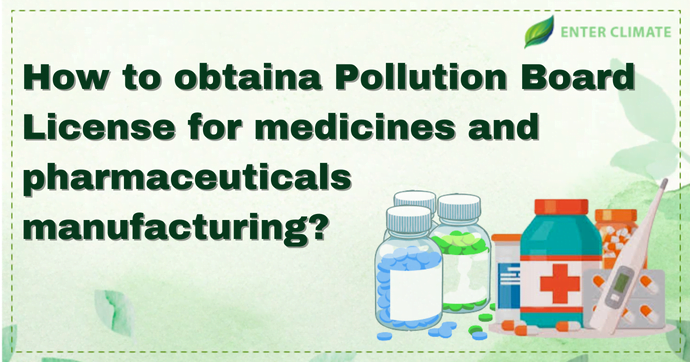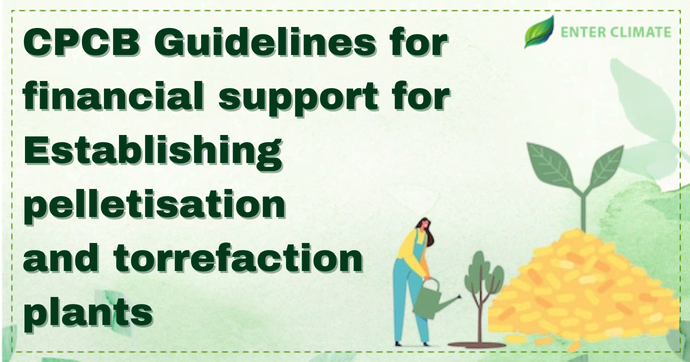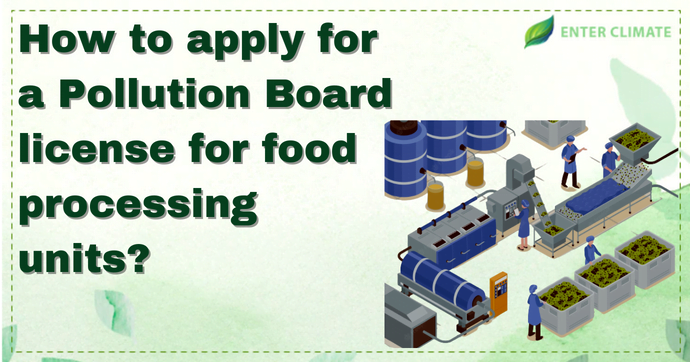How to obtain a Pollution Board License for medicines and pharmaceuticals manufacturing?
 21 Dec, 2022
21 Dec, 2022 
India is the largest manufacturer of generic drugs globally. The total annual turnover of the pharmaceutical industry in 2019-2020 was Rs. 2,89,998 crores. India is also one of the biggest suppliers of low-cost vaccines because of the low price and high quality. Indian medicines are preferred worldwide, rightly making the country the “Pharmacy of the World”. The Pharma sector currently contributes to around 1.72% of the country’s GDP. Numerous efforts by different stakeholders in the industry have helped India achieve this status. The role of the environment agencies and waste management sector must be addressed in this regard. The pharmaceutical industry has been categorised as a red-category industry by CPCB and therefore needs Pollution Board License for medicines and pharmaceuticals manufacturing.
Therefore, the management of waste generated by this industry, such as hazardous chemical, biomedical, radioactive, e-waste and solid waste, needs management as per the applicable laws and Acts. The Environment (Protection) Act mandates scientific treatment of this waste by the pharma industry involved either in the manufacturing of drugs as well as those facilities involved in pharmaceutical formulation for R & D purposes and not for commercial purposes. The Air Act and the Water Act mandate that industries obtain a Consent Certificate for the discharge of Industrial waste after proper treatment. This article will focus on getting a Pollution Board License for medicines and pharmaceutical manufacturing.
Waste Management in the Medicine and Pharmaceutical Manufacturing Market
The pharmaceutical industry generates all sorts of pollution, which is why the Pollution Board License for medicines and pharmaceutical manufacturing is needed. Manufacturing activities have been identified among the 17 most polluting activities and placed in the red category by the CPCB. Apart from the Pollution NOC, the industry has to manage the following waste and thereby either obtain the authorisation from the State Pollution Control board and the Central Pollution Control Board or avail the service of recyclers.
Hazardous Waste: Some drugs contain heavy metals, endocrine disruptors, and other dangerous compounds for animals and the environment. To manage pharmaceutical wastes, a pharmacy management plan must be established to identify hazardous and non-hazardous wastes. Due to the unique chemical characteristics of waste generated by the industry, the Pollution Board License for medicines and pharmaceuticals manufacturing is needed as the industry generates hazardous waste too. The best management practices must be implemented to determine the waste status and comply with guidelines for waste transport and disposal.
Bio-medical Waste: The industry generates all kinds of biomedical waste from clinical trials, unusable or expired medicines, sharp objects, glass etc. It will need an authorisation for Biomedical Waste authorisation under the Biomedical Waste Management Rules, 2016.
E-Waste: The R&D and laboratory works require electronic and medical devices that must be disposed of as per the E-waste Management Rules 2016 after the end of life. Therefore an e-waste management plan must also be prepared along with Pollution Board License for medicines and pharmaceuticals manufacturing.
Radioactive waste from Pharmaceutical Industry: many times, the unit uses radioactive isotopes and elements for diagnostic and therapeutic applications. The waste generated from such activities must be disposed of as per the Atomic Energy (Safe disposal of radioactive waste) rules of 1987.
Plastic waste: apart from plastic biomedical waste, the industry also uses plastic packaging for packaging the product and, therefore, must obtain EPR authorisation and subsequently manage the waste generated by the end of life of that product.
Role of CDSCO in the licence for medicines and pharmaceuticals manufacturing
The Central Drugs Standard Control Organisation(CDSCO), under DGHS, is India’s National Regulatory Authority (NRA). CDSCO is responsible for approving drugs, laying down their standards, the conduct of clinical trials and control over the quality of imported drugs in the country. It also coordinates with the activities of State Drug Control Organizations by providing expert advice to bring about uniformity in enforcing the Drugs and Cosmetics Act. The Drugs & Cosmetics Act of 1940[1] has entrusted various responsibilities to Central & State regulators for regulating drugs and cosmetic items in the country. It envisages implementation of the provisions of the Act and rules for ensuring the safety, rights and well-being of the patients by regulating Drugs and Cosmetic products.
Process of Obtaining Pollution Board Licence for medicines and Pharmaceutical Units
All manufacturers that are directly or indirectly related to the manufacturing of medicines and are required to obtain a Pollution Board License for medicines and pharmaceuticals manufacturing from their concerned State Pollution Control Board or Pollution Control Committee and subsequently obtain a drug license from the Drugs Controller General (India) and the Central Drugs Standard Control Organization (CDSCO). Continue reading to find out the details about this licence and the other authorisation required by the manufacturers in this regard.
Pollution Board License for medicines and pharmaceuticals manufacturing: CTE
Process of obtaining Consent to Establish (CTE) for new units: The new industrial units falling under the Red category list issued by CPCB has to apply for Consent to Establish through the online portal (OCMMS) of the respective state Pollution Board along with all documents and self-certification is submitted by the unit. Although no site inspection is required at this stage, to deal with the cases of any violation, the Board can issue a site inspection at this stage and a list of documents required for a Pollution Board License for medicines and pharmaceuticals manufacturing for CTE are
- Duly filled application form to the concerned SPCB/ PCC.
- Signed undertaking by the project proponent
- Site or layout plan
- Detailed project report
- Details of the unit’s manufacturing processes, sources of effluent discharge and solid, plastic, and radioactive waste that may be generated.
- Details of finished products
- List of machinery and the capital cost of the unit (land, building, and plant machinery)
- Water balance, source of water and its required quantity
- Land documents such as rent/lease agreement
- Industry registration documents
- Consent fee (as applicable)
Pollution Board License for medicines and pharmaceuticals manufacturing: CTO
For new industries, consent to operate is issued after submitting documents mentioned in the online application. Proof of periodic returns is not needed for the consent to operate unless the application is for renewal. The documents required for a Pollution Board License for medicines and pharmaceuticals manufacturing for CTO include
- Duly filled application form to the concerned SPCB/ PCC.
- Balanced sheet certified by a CA
- Copy of CTE issued
- Proof and details of air and water pollution control devices
- Sources of solid waste, biomedical and hazardous waste management facilities provided along with their location on the premises and exit points of the discharge)
- Lab report of the trade emissions and effluents from SPCB-certified labs
- Copy of any permission required from the state government, such as environmental clearance
- Any other document specified in the application for Pollution Board License for medicines and pharmaceuticals manufacturing
In case of Consent to Operate renewal, the concerned SPCB can also ask for past records of post-compliance formalities like quarterly and annual returns.
Pollution Board License for medicines and pharmaceuticals manufacturing: FSSAI Licence
- The standards for health supplements, nutraceuticals, food for special dietary use, food for particular medical purposes, functional food, and novel foods manufactured by the pharma industry are specified under Food Safety and Standards. Regulations, 2016. These regulations cover eight categories of Functional foods, namely,
- Health Supplements,
- Nutraceuticals,
- Food for Special Dietary Use,
- Food for Special Medical Purposes,
- Speciality food containing plant or botanicals,
- Foods containing Probiotics,
- Foods containing Prebiotics and
- Novel Foods
Advantages of setting up a unit in the Pharmaceutical Industry
The popularity of the Indian Pharmaceutical Industry: Indian medicines and pharma products have wide acceptability in the international market. India is the 4th largest Asian medical devices market and ranks among the top 20 global medical device Industries.
Scope of Export: The Indian pharmaceutical industry is the world’s 3rd largest by volume and 14th most significant in terms of value. Exports and imports were Rs. 1,46,260 crore and Rs. 42,943 crores, respectively, in the same year
FDI: Pharmaceutical is one of India’s top ten attractive sectors for foreign direct investment (FDI). A 100% FDI is allowed under automatic route in Medical Devices. Also, 100% FDI in pharmaceutical greenfield projects is permitted under the automatic way. For brownfield pharmaceutical projects, FDI beyond 74% to up to 100% requires government approval.
Scope of Growth: There is still immense scope for new entrants in this segment. There is still the need to attain self-reliance in bulk drugs and new technologies for manufacturing APIs. DoP prepared schemes for promoting the manufacturing of critical KSMs, APIs and Drug Intermediates by attracting investments in the sector to ensure their sustainable domestic supply and thereby reduce India’s import dependence on other countries for these products.
Conclusion
In the wake of Covid, the Indian pharma Industry undertook the arduous task of providing medicines, vaccines and other medical supplies to numerous developing and developed nations. Access to affordable HIV treatment from India is among the many great success stories. Many manufacturers in the pharma industry reap the benefits from this positive image. The supply gap in international market supply due to increased demand also presents a business opportunity for entrepreneurs in manufacturing products listed above. However, waste management and post-compliance with CPCB and SPCB guidelines is a cumbersome task that needs to be dealt with carefully. Obtaining a Pollution Board License for medicines and pharmaceuticals manufacturing and post-compliance management with domain experts will be beneficial for any manufacturer in the segment. It will provide the edge to the business and prove a crucial factor in its growth by allowing the business proponent to focus on their goals and leaving the legalities to the people trained in it.













